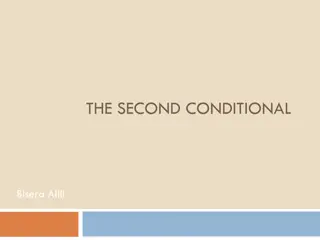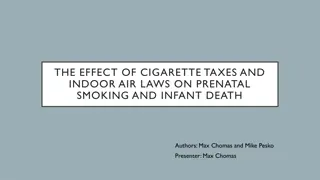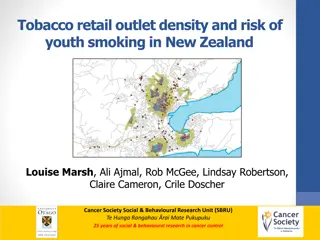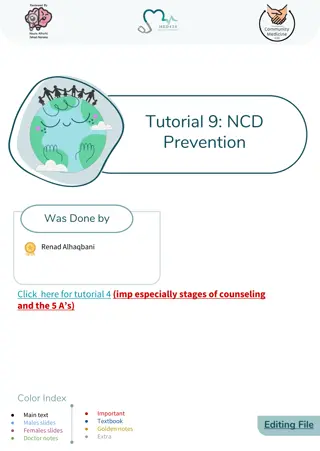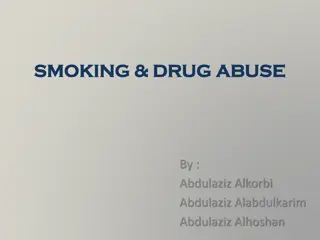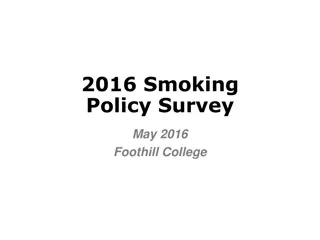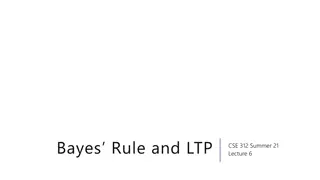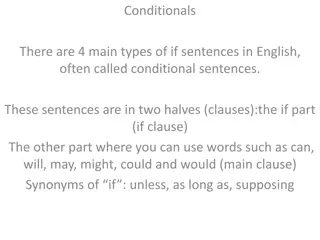Understanding Conditional Probability through a Smoking Survey
Explore conditional probability through a smoking survey where probabilities of being a male who smokes, being a male in general, and smoking irrespective of gender are calculated based on provided data. The calculations help illustrate how probabilities can be derived from different scenarios within a given sample space.
Download Presentation

Please find below an Image/Link to download the presentation.
The content on the website is provided AS IS for your information and personal use only. It may not be sold, licensed, or shared on other websites without obtaining consent from the author. Download presentation by click this link. If you encounter any issues during the download, it is possible that the publisher has removed the file from their server.
E N D
Presentation Transcript
Conditional Probability AS91585
Section One THE LANGUAGE OF PROBABILITY QUESTIONS.
The question, "Do you smoke?" was asked of 100 people. Yes Male 19 Female 12 Total 31 . No 41 28 69 Total 60 40 100 The results are shown in the table.
(i) What is the probability of a randomly selected individual being a male who smokes? . Male Female Total Yes 19 12 31 No 41 28 69 Total 60 40 100
(i) What is the probability of a randomly selected individual being a male who smokes? . Male Female Total Yes 19 12 31 No 41 28 69 Total 60 40 100 This is just a joint probability question: The number of "Male and Smoke" divided by the total = 19/100 = 0.19
(ii) What is the probability of a randomly selected individual being a male ? . Male Female Total Yes 19 12 31 No 41 28 69 Total 60 40 100
(ii) What is the probability of a randomly selected individual being a male ? . Male Female Total Yes 19 12 31 No 41 28 69 Total 60 40 100 This is the total for male divided by the total = 60/100 = 0.60. Since no mention is made of smoking or not smoking, it includes all the cases.
(iii) What is the probability of a randomly selected individual smoking? . Male Female Total Yes 19 12 31 No 41 28 69 Total 60 40 100
(iii) What is the probability of a randomly selected individual smoking? . Male Female Total Yes 19 12 31 No 41 28 69 Total 60 40 100 Again, since no mention is made of gender, it is the total who smoke divided by the total = 31/100 = 0.31.
(iv) What is the probability of a randomly selected male smoking? . Male Female Total Yes 19 12 31 No 41 28 69 Total 60 40 100
(iv) What is the probability of a randomly selected male smoking? . Male Female Total Yes 19 12 31 No 41 28 69 Total 60 40 100 This time, you're told that you have a male, so we only consider the males. What is the probability that the male smokes? Well, 19 males smoke out of 60 males, so 19/60
(v) What is the probability that a randomly selected smoker is male? . Male Female Total Yes 19 12 31 No 41 28 69 Total 60 40 100
(v) What is the probability that a randomly selected smoker is male? . Male Female Total Yes 19 12 31 No 41 28 69 Total 60 40 100 This time, you're told that you have a smoker and asked to find the probability that the smoker is also male. There are 19 male smokers out of 31 total smokers, so 19/31
Section Two CREATING TABLES
Question 2 There are three major manufacturing companies that make a product: Aberations, Brochmailians, and Chompielians. Aberations has a 50% market share, and Brochmailians has a 30% market share. 5% of Aberations' product is defective, 7% of Brochmailians' product is defective, and 10% of Chompieliens' product is defective.
Choose 1000 for the total Company Good Aberations Brochmailians Chompielians Total Defective Total 1000 Use A, B and C to save writing time
Aberations has a 50% market share, and Brochmailians has a 30% market share. Company Good A B C Total Defective Total 500 300 200 1000 Fill in gaps as you go.
5% of Aberations' product is defective, 7% of Brochmailians' product is defective, and 10% of Chompieliens' product is defective. Company Good A B C Total Defective Total 25 21 20 66 500 300 200 1000
5% of Aberations' product is defective, 7% of Brochmailians' product is defective, and 10% of Chompieliens' product is defective. Company Good A 475 B 279 C 180 Total 934 Defective Total 25 21 20 66 500 300 200 1000 Fill in the gaps
What is the probability a randomly selected product is defective? Company Good A B C Total Defective Total 25 21 20 66 475 279 180 934 500 300 200 1000
(i) What is the probability a randomly selected product is defective? Company Good A B C Total Defective Total 25 21 20 66 475 279 180 934 500 300 200 1000 66/1000=0.066
(ii) What is the probability that a defective product came from Brochmailians? Company Good A B C Total Defective Total 25 21 20 66 475 279 180 934 500 300 200 1000
(ii) What is the probability that a defective product came from Brochmailians? Company Good A B C Total Defective Total 25 21 20 66 475 279 180 934 500 300 200 1000 P(Brochmailian|Defective) = P(Brochmailian and Defective) / P(Defective) = 21/66 = 7/22 = 0.318 (approx).
(iii) Are these events independent? Company Good A B C Total Defective Total 25 21 20 66 475 279 180 934 500 300 200 1000
(iii) Are these events independent? Company Good A B C Total Defective Total 25 21 20 66 475 279 180 934 500 300 200 1000 No. If they were, then P(Brochmailians|Defective)=0.318 would have to equal the P(Brochmailians)=0.30, but it doesn t i.e. if independent: PBD P D ( ) ( ) ( ) P D P D ( ) ( ) )=P B D ( =P B ( ) = P B
SECTION THREE PRACTICING METHODS
Using Tree diagrams There are three major manufacturing companies that make a product: Aberations, Brochmailians, and Chompielians. Aberations has a 50% market share, and Brochmailians has a 30% market share. 5% of Aberations' product is defective, 7% of Brochmailians' product is defective, and 10% of Chompieliens' product is defective.
(i) What is the probability a randomly selected product is defective? There are three major manufacturing companies that make a product: Aberations, Brochmailians, and Chompielians. Aberations has a 50% market share, and Brochmailians has a 30% market share. 5% of Aberations' product is defective, 7% of Brochmailians' product is defective, and 10% of Chompieliens' product is defective.
P D ( )=0.5 0.05+0.3 0.07+0.2 0.1=0.066 0.05 D A Not D D 0.5 0.07 0.3 B Not D 0.2 0.1 D C Not D
(ii) What is the probability that a defective product came from Brochmailians? There are three major manufacturing companies that make a product: Aberations, Brochmailians, and Chompielians. Aberations has a 50% market share, and Brochmailians has a 30% market share. 5% of Aberations' product is defective, 7% of Brochmailians' product is defective, and 10% of Chompieliens' product is defective.
0.30.07 ( )= 0.5 0.05+0.3 0.07+0.2 0.1=0.021 0.066=7 PBD 22 0.318 0.05 D A Not D D 0.5 0.07 0.3 B Not D 0.2 0.1 D C Not D
Question Three Players are strongly advised to warm up before playing sports games to reduce their risk of injury from playing the game. For a particular sports team of 20 players: 14 of the players warmed up before the last game 5 of the players were injured during the last game 2 of the players did not warm up and were not injured during the last game. Using this information, calculate the probability that a randomly chosen player from the team was injured, given that the player did not warm up before the last game.
Venn Diagram Injured Warmed up 20 13 1 4 4 6=2 3 2
Table initial information Warmed Up Did not warm up Totals Injured Not Injured 5 2 14 20
Table fill the gaps Warmed Up Did not warm up Totals Injured Not Injured 1 4 2 5 13 15 14 6 20 4 6=2 3
Question 4 On a certain type of aircraft the warning lights (showing green for normal and red for trouble) for the engines are accurate 90% of the time. If there are problems with the engines on 2% of all flights, find the probability that there is a fault with an engine, given that the warning light shows red.
We can also create a table: Assume we look at 1000 flights Red Green Trouble OK Totals 20 980 1000 problems with the engines on 2% of flights
We can also create a table: Assume we look at 1000 flights Red 18 Green Trouble OK Totals 20 980 1000 882 warning lights are accurate 90% of the time
We can also create a table: Assume we look at 1000 flights Red 18 98 116 Green 2 882 884 Totals 20 980 1000 Trouble OK Totals Finish the table
find the probability that there is a fault with an engine, given that the warning light shows red. Red 18 98 116 Green 2 882 884 Totals 20 980 1000 Trouble OK Totals 18 116=9 58
R 0.9 T 0.02 0.1 G R 0.1 0.98 T 0.9 G 0.02 0.9 0.02 0.9+0.98 0.1=0.155
SECTION FOUR READING TABLES
Question 5 One of the biggest problems with conducting a mail survey is the poor response rate. In an effort to reduce nonresponse, several different techniques for formatting questionnaires have been proposed. An experiment was conducted to study the effect of the questionnaire layout and page size on response in a mail survey. The results are given below.
Format Typewritten (small page) Typewritten (large page) Typeset (small page) Typeset (large page) Total Responses Nonresponses Total 57 86 143 191 97 288 72 69 141 192 92 284 541 315 856
(a) What proportion of the sample responded to the questionnaire? Format Typewritten (small page) Typewritten (large page) Typeset (small page) Typeset (large page) Total Responses Nonresponses Total 57 86 143 191 97 288 72 69 141 192 92 284 541 315 856
(a) What proportion of the sample responded to the questionnaire? Format Typewritten (small page) Typewritten (large page) Typeset (small page) Typeset (large page) Total Responses Nonresponses Total 57 86 143 191 97 288 72 69 141 192 92 284 541 315 856 541 856
b. What proportion of the sample received the typeset small-page version? Format Typewritten (small page) Typewritten (large page) Typeset (small page) Typeset (large page) Total Responses Nonresponses Total 57 86 143 191 97 288 72 69 141 192 92 284 541 315 856 141 856
What proportion of those who received a typeset large- page version actually responded to the questionnaire? Format Typewritten (small page) Typewritten (large page) Typeset (small page) Typeset (large page) Total Responses Nonresponses Total 57 86 143 191 97 288 72 69 141 192 92 284 541 315 856 192 284=48 71
What proportion of the sample received a typeset large-page questionnaire and responded? Format Typewritten (small page) Typewritten (large page) Typeset (small page) Typeset (large page) Total Responses Nonresponses Total 57 86 143 191 97 288 72 69 141 192 92 284 541 315 856 192 856=24 107
(e) What proportion of those who responded to the questionnaire actually received a type-written large page questionnaire? Format Typewritten (small page) Typewritten (large page) Typeset (small page) Typeset (large page) Total Responses Nonresponses Total 57 86 143 191 97 288 72 69 141 192 92 284 541 315 856 191 541









